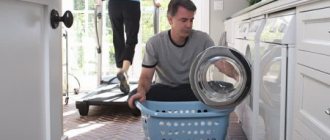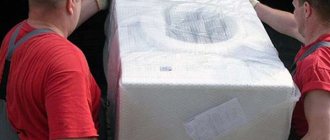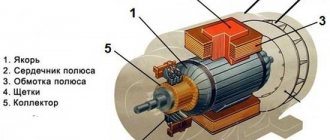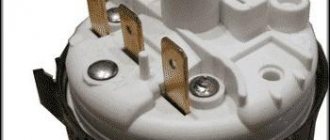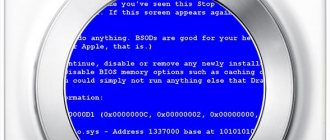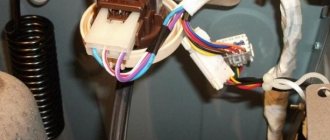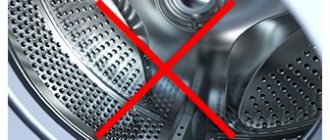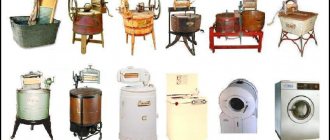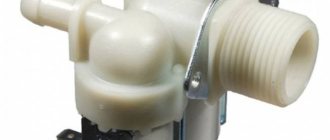An automatic washing machine (AWM) without an electric motor is nothing more than a tank or stand for things. The mechanical rotation of the moving elements responsible for washing occurs thanks to the “heart” of the device - its motor. The quality of washing and the energy efficiency of the model depend on the characteristics of the electric motor. Let's figure out what washing machine engine power is considered optimal and why the user should be interested in this question.
What types of engines are there?
Developers select a motor for a washing machine taking into account the characteristics being implemented. There are three types of electric motors used in automatic washing machines:
- Asynchronous. There are 2- and 3-phase. In modifications of the SMA released after 2000, only 3-phase versions are used. Their power is 180–360 W. They can provide almost 300 revolutions per minute in the wash. In machines with asynchronous motors, the rotation of the drum during spinning is quite small - up to 600 rpm, very rarely this figure approaches 1000.
- Collector. This electric motor is more advanced than an asynchronous one. It operates on any type of current - alternating or direct. It has smaller dimensions, which means the device will be less bulky and heavy. In such engines, the command block smoothly regulates the number of revolutions per minute. But there is also a minus - commutator motors have brushes. These elements not only create noise, but also wear out intensely - as they wear out, they have to be replaced. They are rated at 380–800 W.
- Brushless. Scientists at the Korean concern LG have been thinking for a long time about how to increase the power of an electric motor without increasing the energy consumption of the SMA. The brushless motor is capable of rotating the drum at high speeds without wasting energy on belt and brush friction. SMAs with such engines are characterized by high efficiency. This is the last type of engine in the chronology of inventions. They first began to be installed on SMA in 2005 at LG factories. Its main difference is direct drive and compact dimensions. A washing machine with a brushless motor does not have a belt drive. Such washing machines are characterized by silent operation - there are no brushes or belts, and high efficiency. Power characteristics are similar to the options described above. It is capable of rotating the drum at speeds up to 2000 rpm.
How to find out how many revolutions an electric motor has? Look at the information plate that is available on any electric motor.
Important! The engine power consumption depends on the operating mode - washing or spinning. The value of this parameter is not indicated in the technical documentation for the SMA; it must be looked at directly on the motor itself.
Which to choose?
At first glance, it may seem that the inverter motor has more advantages, and they are more significant. But let’s not rush to conclusions and think a little.
Above 1000 rpm, everything is already unnecessary, since even at this speed things are squeezed out perfectly.
It is difficult to answer unequivocally which motor for a washing machine will be better. As can be seen from our findings, the high power of an electric motor and its inflated characteristics are not always relevant.
If the budget for purchasing a washing machine is limited and limited, then you can safely choose a model with a commutator motor. If you have a wider budget, it makes sense to buy an expensive, quiet and reliable inverter washing machine.
If you are choosing a motor for an existing car, then first of all you need to carefully study the issue of compatibility of power units.
Here you need to take into account every detail and characteristic.
What are the power characteristics of an electric motor?
The rotation speed of the drum of an automatic washing machine—the number of revolutions it makes per minute—depends on the type and power of the engine. The higher the speed, the better the spin. However, you need to remember that not all fabrics can withstand such speeds without consequences. For a more gentle push-up, set the speed lower - in modern machines you can adjust the spin speed. And the technical documentation indicates its maximum value.
The electric motor determines how much electricity the entire washing machine consumes. The number of kWh that the device will “wind up” depends on its power indicators. When buying household appliances, the consumer is not interested in the power characteristics of the electric motor, but in how much he will have to pay for the light. Energy consumption is a value that depends on several factors. The number of kilowatts consumed per hour is affected by power:
- electric motor;
- heater - 1.7–2.9 kW, the hotter the water, the greater the value;
- pumps - 0.024–0.040 kW, this is enough to pump out dirty water;
- sensors, control unit and display - 0.005–0.010 kW.
Comparison of performance characteristics of washing machine motors
Let's analyze some of the operating parameters that always worry the end user, who expects positive results from investing his money in the purchase of complex household appliances.
How electrical energy is consumed by different types of motors: which one is better?
This issue is so pressing that the European Union Commission, through its directives, has strictly established technical control standards. The latest changes for washing machines and clothes dryers were approved in 2010.
Such products are assigned an energy efficiency label, which takes into account the energy consumption for processing 1 kg of laundry (cotton cycle under control of a certain water temperature).
The most frugal models are assigned an A+++ grade, while the spendthrifts are assigned a D grade.
In other words, all the work of determining the cost of electrical energy for washing clothes and calculating the quality of washing is carried out for us by the EU Commission on Energy and Transport. Its results can be completely trusted.
To do this, when purchasing equipment, it is enough to familiarize yourself with the energy efficiency label, which manufacturers of branded devices do not hesitate to display directly in the most visible place of the case - the upper left corner.
If we consider separately the energy consumption of single-phase asynchronous, commutator or inverter motors, then you can make a lot of mistakes yourself, because they have different regulation principles:
In addition, any owner of a washing machine is interested not so much in the economical operation of the engine alone, but of the entire machine as a whole, purchased for washing. After all, energy losses can occur in other places:
How much does SMA consume?
When choosing a washing machine, buyers evaluate it according to a standard set of criteria. Usually they are interested in modes, drum loading, dimensions, loading type, drum illumination and other visible functions. But people are rarely interested in kilowatts. The lower the energy consumption class, the more electricity is spent, the higher the electricity bills. Today, almost all SMAs belong to group A. The exception is devices with a drying function - but here you have to sacrifice savings for the opportunity to receive dry laundry.
Energy consumption can be easily determined by the energy efficiency class. Thus, models A+++ consume 0.13 kWh, and, for example, group C - 0.25 kWh. Power consumption of class A SMA is up to 0.31 kWh. Equipment of groups E, F and G is not used in everyday life. Its consumption is respectively 0.39 and 0.4 kWh.
Which engine type is better
After familiarizing yourself with the operating principle of each type of motor, most readers may not have a question about which one is better. In principle, all characteristics speak in favor of the inverter motor. But is everything so clear?
If we talk about energy efficiency, then inverter-type machines with direct drive are more economical than collector ones. They just don’t have to expend additional energy to overcome the frictional force of the brushes with the rotor and the belt with the drum. But the savings are not so noticeable as to speak of an undeniable advantage.
As for the noise level, universal electric motors are also inferior to the Digital Inverter. In the first type, additional noise occurs due to rubbing parts, which are completely absent in the second.
Spinning at high speeds is a good feature of a washing machine. Digital Inverter can provide rotations up to 2000 rpm. But do your clothes need such a spin? Are you not afraid for their condition after systematically running high speeds? In most cases, 1000 rpm is enough for the clothes to dry in a few hours.
Source
Which class should I choose?
Consumption depends on the amount of laundry loaded, the set temperature, and the selected mode—duration and intensity of washing. On the information labels, the manufacturer indicates the maximum power of the device, which reaches 4 kW.
The indicator is designated by the letter P - it allows you to evaluate the “appetites” of the machine. This is a kind of potential: what she can consume maximum. It turns out that no matter what mode is selected, the device is not able to consume more than the set limit. There is no particular point in buying devices with classes A+++ and A++ - there is little savings, but the overpayment for “high energy efficiency” is significant. The consumption of cars of groups B and C differs insignificantly from analogues of group A.
Which engine type is better
When figuring out which type of engine to buy, first of all decide on the requirements for the future washing machine.
If you are ready for noisier operation and constant maintenance of the machine, but want to save a lot, buy an SMA with a commutator motor. If price doesn’t matter to you, but your priority is power, noiselessness and durability, then it’s better to give preference to a machine with an inverter motor.
Attention! The manufacturer's warranty on the brushless motor is at least 10 years! But this does not eliminate the risk that other parts of the car will deteriorate much earlier than the warranty period for the engine expires.
Source
Types of electric motors
The washing machine motor converts electrical energy into mechanical energy, causing the drum to rotate. There are three types of motors for automatic washing machines:
- asynchronous motors - there are two- and three-phase. The power of such motors for washing machines reaches 180 - 360 W, their speed is not too high - up to 2,800 per minute during the spin process and about 300 during the washing process;
- commutator electric motors - can operate not only from direct, but also from alternating current. They are small in size and the engine speed can be adjusted electronically. The main disadvantage is the brushes, which wear out during use and have to be changed periodically. The power of the commutator motor reaches 380 - 800 W, the armature rotates at a frequency of 11,500 - 15,000 revolutions per minute;
- brushless - they are also called inverter. Such motors first became known in 2005, when Lg began installing them on its laundry washing machines. The main difference is that a belt drive is not required to connect the motor and the drum, everything happens directly. This type of engine is the most compact, structurally simple, and has the highest efficiency. The power of such electric engines are not inferior to the above samples, the number of revolutions in the process of squeezing clothes is 1,600 - 2,000 per minute.
How to choose an automatic washing machine by engine type
When purchasing large household appliances, any user carefully selects characteristics and functions, searches for information on manufacturers and models, trying to purchase the best available on the market based on the allocated budget. We have already written general instructions for choosing a washing machine, and now we will consider in more detail which engine to choose, the advantages, disadvantages and the most common breakdowns of each type.
The washing machine motor converts electrical energy into mechanical energy and causes the drum to rotate during washing - this is the main element, the “heart” of the device. From the invention of the first engines to the present day, belt drives have been used to transmit torque from the motor to the drum. But technology is constantly evolving, and now direct drive machine models are especially popular on the market.
At the moment, you can find three types of motors: asynchronous, commutator and inverter.
How energy consumption depends on the motor power value
To simplify the issue, let’s figure out how much electricity in kilowatts the motor of your car can generate in an hour of operation. This data interests us more often, but what exactly is the power of the engine itself is a second question.
It is believed that the energy consumption of a device for washing clothes is formed from:
- electricity consumed by the motor, which during operation can vary depending on the operations performed;
- values of a water heating device, the average of which is 1.7 - 2.9 kW. And the amount of energy consumed will depend on the set water temperature;
- the pump power is 24 0 40 W, which is quite enough to drain the liquid;
- the total power value of the light bulbs, module, sensor devices, which reaches 5 - 10 W.
Parameters affecting power
To understand how much electricity a washing machine consumes per hour, add up the energy consumption of all its components.
- An electric motor rotates the drum. During simple washing, consumption decreases, and during drying mode it increases. On average, the engine consumes 0.4–0.8 kW. Motors are commutator, direct drive and asynchronous.
- The heating element heats the water and makes the spin automatic. It is turned off in cold rinse mode, but works at maximum during heating and spinning. The more powerful the heating element, the less time it will take to heat the water. Heating element indicators: from 1.7 to 2.9 kW.
- The pump pumps out water according to the specified program. It requires 25 to 40 watts depending on the model.
- Electronic control consumes up to 10 watts, mechanical control takes no more than 5 watts. The control system includes starting capacitors, an electronic module, light bulbs, a programmer and other small radio elements.
Read also: How to weld a cast iron pipe
By adding the indicators of all components, you can find out the number of kilowatts consumed.
Engine power of various SMA models
Washing machines from different manufacturers are equipped with electric motors that differ not only in cost, but also in technical parameters. Here are the main devices:
- MOTOR CESET MCA 52/64-148/AD9 – such engines are installed on Indesit and Hotpoint-Ariston machines, their power level at 11,500 rpm reaches 430 W;
- MOTOR CESET MCA38/64-148/CY15 – motors for units from Kandy, Zerovatt and Hoover companies. At 360 W they produce 13,000 rpm;
- MOTOR CESET CIM2/55-132/WHE1 – electric motors of this series can be found on washing units with a power rating of 800 W and a speed of 17,000. Examples of devices are Whirlpool and Bauknecht;
- WELLING HXGP2I.05 WASHING – another engine option for Indesit, also found on Vestel. When spinning, the power is 300 W, during washing it decreases tenfold;
- Elecronic Control Motor Haier HCD63/39 - this motor can be seen on Kandy or Haier; its power rating is 220 W, speed is 13,000;
- HXGP2I Welling Electronic Control Motor - motors of this brand are installed on devices for washing clothes from Samsung and Ardo, their power does not exceed 300 W.
Many people are interested in whether it is possible to make adjustments on modern engines, and how to increase the power of the unit? How to lower the speed so as not to disrupt performance? In this case, it is necessary to connect a tachogenerator, which transmits the number of turns to the microcircuit of the regulatory device, which coordinates the entire process through a thermistor.
What motors are used in a washing machine?
As already noted, automatic machines use three types of motors. They all have different structures and also differ in operating principles. This will be discussed further.
Asynchronous electric motor
Asynchronous motors for washing machines also have a division:
Two-phase ones are considered obsolete and have hardly been used since the 2000s. They were replaced by more advanced three-phase ones. They consist of two main parts: a stationary stator and a rotor placed inside it. It is the latter that drives the drum. How does this happen? The rotor is connected to the drum by a belt that transmits rotation. So when the rotor turns, the drum also turns. The number of revolutions per minute can reach up to 2800.
An asynchronous electric motor has the following advantages:
Among the shortcomings we note:
Such a motor is found in cheap models of automatic machines, as well as in semi-automatic washing machines. More modern and powerful models do not have them.
Commutator motors
A commutator or universal electric motor is used in most automatic machines. It can operate on both direct current and alternating current. This is where its versatility lies.
The main components of the motor are:
Some models of automatic cars from Bosch and Siemens have a Hall sensor instead of a tachogenerator.
The transmission of rotation is ensured by a belt that connects the drum pulley to the drive.
The advantages of a universal electric motor are as follows:
The disadvantages include:
Low efficiency is also a disadvantage. This is due to the fact that part of the energy is spent on overcoming the frictional force of the belt transmitting rotation.
Direct Drive Inverter Motor
The main thing to distinguish them is in the drive. In the first case, a belt drive is used, in the second, the drive is connected directly.
It is the latest technology that is used in LG automatic machines. Over time, other manufacturers of household appliances began to use it, since automatic machines with direct drive were liked by consumers for a number of significant advantages. But we'll talk about them a little later.
What is special about Digital Inverter? It, like the commutator, consists of a rotor and a stator, but there are no brushes in it. Its operating principle is completely different.
An inverter is used to connect the machine to the electrical network.
This element controls the speed of the electric motor, converting alternating current into direct current. This allows you to control the mechanism with extreme precision.
Advantages of washing machines with Digital Inverter:
The disadvantage of Digital Inverter is its high cost. And in the event of a breakdown, repairs will require equally expensive components. This is due to a more complex control scheme. However, most manufacturers provide a 10-year warranty on these engines.
Connecting the washing machine motor
To connect the motor to alternating current, perform the following steps:
1
.
First you need to prepare a tester - this is a special device used to determine the winding wires. 2
.
To determine a pair of wires, connect the tester probe to any wire and check all the others one by one. If during connection the tester indicated a connection, then this will be a pair of wires. Accordingly, the other two wires will also form a pair. 3
.
We measure the resistance level of two windings. The winding with a higher value is the starting winding. 4
.
Wires from different windings are connected in pairs, then connected to a 220 V network 5
. It is recommended to install the switch on the starting winding wire.
In some cases, the direction in which the motor rotates must be changed. Here we swap the leads of the starting winding.
Engine” from an old washing machine for a lathe
Assembling a lathe yourself is not a difficult task. All you need to do is fix the adapter on the base of the motor shaft from an old washing machine. The adapter should not be permanently secured. It is better if it is removable, since this way the lathe will become multifunctional, with the ability to turn parts, sharpen knives with a sharpening wheel, cut metal and plastic pipes with a cutting wheel, and use other attachments. The photo shows possible attachments.
You should not fix this homemade product on a solid base. To make work more convenient, it is recommended to make it portable. The basis will be a thick, durable board. To secure the resulting lathe, it is recommended to use brackets that are screwed onto the base using bolts from the washing machine. A regular switch can be used, or from a washing machine.
What motors are used in a washing machine?
Let's look at each type of engine separately, assessing their strengths and weaknesses so that you can make an informed choice when selecting equipment.
Asynchronous
Washing machines use both two-phase and three-phase motors. But since the 2000s, the first type has gone into oblivion, and today more compact 3-phase motors with the ability to regulate the speed are used.
They are designed in this way: their design includes two parts - a stator (immovable) and a rotor (providing rotation of the drum). Such a motor can rotate up to 2.8 thousand revolutions in 1 minute.
Weakness of the asynchronous type engine: weakening of the torque, which causes the drum to sway and lose power during rotation. But if your washing machine has an asynchronous type motor, then the following advantages await you:
Experts cite the following disadvantages:
In powerful SMAs of recent years, such motors are no longer used. They can only be found in simple models from a low price category.
Collector
8 out of 10 household appliances include just such ED in their design. In washing machines, commutator motors began to be used in the early 90s, and already a decade later they almost completely replaced asynchronous two-phase analogues. Their main advantage is their versatility and operation from direct and alternating current.
The design of the collector type engine is as follows:
Important! The brushes rub against the commutator, so they wear out over time and require replacement. You can notice worn brushes by sparks from under the bottom panel of the MCA.
Disadvantages also include the risk of interturn short circuit (winding breakdown), which causes loss of power or spark.
Direct drive
The so-called inverter motor is used by LG, whose experience was subsequently adopted by other brands. These electric motors entered the market in the mid-2000s and were immediately liked by customers for a number of undeniable advantages. Today, direct drive motors can be found in washing machines of the following brands: Samsung, Haier, Whirlpool, Hotpoint-Ariston, Bosch, AEG and others.
The ability to use brushless technology made it possible to make SMs smaller in size and maintain the functionality of other parts. As in the previous type of motor, the inverter design has a rotor and a stator, but the operating principle is different. The main difference is in the drive. It is directly connected to the drum, so washing machines do not have a belt drive.
Among the shortcomings, experts point out only that the control scheme of such an engine is much more complicated than that of its analogues. This directly proportionally affects the price of such washing machines.
Now you know which motor in the washing machine is the most powerful and quiet. All that remains is to figure out which one is better and what to choose.
Grain crusher from a washing machine
With this useful homemade product, you can significantly save on the preparation of feed for domestic animals. If you choose an engine of sufficient power, it is quite possible to assemble a feed cutter, grain crusher and grass cutter, which will not be inferior in performance to factory models. In this case, it is recommended to use an engine from an automatic washing machine - they are distinguished by higher power.
It doesn't take a lot of work to turn an old washing machine into a feed cutter. You need to take an engine from an automatic machine and a body from another old washing machine - with a top load. It’s quite easy to find such a case; it costs pennies at a scrap metal collection point.
Step-by-step description of creating a feed cutter with your own hands:
1
.
The blades with knives should have a diameter such that they do not reach quite a bit to the edges of the body. 2
.
We make a hole in the bottom to remove the finished food. 3
.
We install one blade with knives in the lower part of the body, the other - 40–50 cm from the upper edge; To ensure better grinding quality, you need to use 2 different shafts for the knives, they should rotate in different directions. 4
.
We screw the motor onto the lid of the washing machine and attach it to the shafts. 5
.
We cut a hole in the lid to fill in the raw materials. 6
. We install the cover in place and test the homemade product in action.
Such a homemade device will function no worse than a factory one, and will allow you to obtain high-quality ground feed.
Second life of an electric motor
From an old, out of order washing machine, it is possible to make many homemade items for household needs. Many of its elements are suitable for this, including the body, drum, covers, etc. But units are most often made for use in household purposes, home workshops or garages - using a motor.
You can use the electric motor from a washing unit, for example, by making a homemade juicer for the kitchen, a vibrating table for the workshop, as well as making many other useful devices and accessories that can greatly simplify certain types of work for a home craftsman.
Grinder
To make a sharpening machine, a high-power motor is not required, and in terms of the number of revolutions, any electric motor from an old washing machine can be suitable.
To build the machine, you need to prepare a base plate for it from a piece of thick wooden board and attach an electric motor and a switch removed from the same washing machine to it. Metal brackets can be used for fastening.
Next, cut the thread and attach the adapter-attachment to the shaft for attaching the grinding wheel. An adapter with a neck for a cutting abrasive wheel can be supplied with the nozzle. Then you will have a cutting machine that can be used to cut plastic pipes, as well as fittings, metal sheets or corners.
The result may be a compact, portable and almost universal sharpening and cutting machine, the manufacture of which will not require the use of electric welding.
Feed cutter and grain crusher
Another homemade product to help those involved in agriculture can be made from an electric motor removed from washing equipment. This is a grain crusher and feed cutter in one.
Converting a laundry machine into a feed cutter doesn't require much effort. To do this, you only need a machine body with top loading of laundry and the electric motor itself. The case can be purchased for pennies at points where scrap metal is accepted or searched at a landfill.
The manufacturing technology of the feed cutting unit itself will be as follows:
- Cutting blades (knives) are made from steel strips, which slightly do not reach the walls of the washing drum.
- At the bottom of the drum, under the knives, a small hole measuring approximately 50x50 mm is made, through which the ground feed will come out.
- The blades are attached to the motor shaft near the very bottom of the washing drum. For more efficient operation of the feed cutter, it is advisable to use two shafts, which should rotate in different directions. If there is a second shaft, additional blades are installed approximately 100-150 mm above the lower knives. Naturally, you will have to install two electric motors: one from below under the feed cutter drum, the other in the middle of the drum
- Install the electric motors and connect them to the shafts with cutting blades.
- You can cut a hole in the lid for placing raw materials into the drum for preparing feed.
A device made on your own will cost much less and will work almost as well as one made in a factory.
Making a mortar mixer
For those who are planning to build or make repairs in the future, the motor from the washing machine can be useful for making a full-fledged mortar mixer, which can facilitate the process of construction work and at the same time save significant money. This will be especially beneficial for residents of rural areas, where the construction process practically never ends.
The process of making a mortar mixer looks something like this:
- The base for the mortar mixer is best made from 50-gauge steel angle. To do this, you need to cut out two pieces of 600 mm each and 4 pieces of 800 mm each, from which two triangles should be welded.
- Nuts are welded to the tops of the triangles, the internal diameter of which must be more than 30 mm.
- The triangles are positioned vertically at a distance of 500 mm from each other, after which a metal pipe is threaded through the nuts, at the ends of which limiters are welded.
- At the bottom, the racks are welded together with two corners, and the result is a rigid structure, to which a frame with a container for mixing the solution will be attached on top.
- The frame is made measuring 1.4 x 0.4 meters from the same corner as the base. In the center of the finished frame, an additional cross member is welded from an angle, after which it is rigidly fixed using electric welding to a pipe inserted into the holes of the nuts.
This design is convenient in that it works like a swing, and the prepared solution can easily be poured out of the mixer by simply tilting the tank.
To mix the solution, it is best to use a washing tub from a top-loading machine. Its capacity is just enough to mix several buckets of solution.
The activator is removed from the tank and the hole for draining the water is tightly closed. Instead of an activator, a shaft is installed on which a steel strip with sheet metal blades is attached inside the tank.
The tank is placed and secured to a movable frame welded to the pipe of the mixer base. An electric motor connected to a shaft is attached externally to its bottom. To do this, two holes are drilled in the bottom of the tank, the same size as those located on the motor housing, after which the tank is rigidly bolted to the barrel.
After this, all that remains is to connect the electric motor and test the operation of the mortar mixer.
Emery from a washing machine motor
An emery machine is useful for almost any household.
It can be made in a simple way - for this it is enough to prepare the engine from an automatic washing machine in working condition. When you attach the sharpening stone to the motor, some difficulties may arise - the hole of the stone may not coincide with the diameter of the electric motor shaft.
In this case, you need to take an additional part that will need to be specially machined. This adapter can be easily made by any turner; you just need to tell him the diameter of the shaft.
In addition to the adapter, you need to have a special bolt, nut, and washer.
The thread on the nut should be cut depending on which direction the motor will rotate.
In order for the motor to rotate clockwise, the thread must be left-handed; for counterclockwise rotation, the thread must be right-handed.
If you do the opposite, the stone will constantly unwind and fly off during work.
It may be that you have a nut, but the thread direction is not correct. Then we change the direction of rotation. In this case, we swap the winding wires.
We connect the working winding to a 200 V network, connect the starting pair to the working coil.
We apply the second end to the winding terminal for a short time. The commutator electric motor will begin to move in one direction.
When the locations of the starting winding terminals change, the direction of movement of the motor will change to the opposite.
The direction of rotation of the motor can be changed without using a capacitor. Here, after connecting the working winding to 220 V, we sharply turn the stone in the right direction.
After this, the motor starts and the machine starts working.
Electric motor for a grinder or emery
Purchasing a ready-made sharpening machine is not always possible, primarily due to the high price, and in this case an electric motor from a washing machine or other equipment literally becomes indispensable.
Read also: Equipment for processing rubber tires
A lot of effort requires the correct layout of the future unit, as well as solving such a technical problem as attaching a grindstone to the motor shaft. In many cases, there is no thread on it, and the diameters of the shaft and the hole in the stone do not match. The usual way out is to use a special part, which must be ordered separately from a turner's workshop. This part may be called a flange, adapter, hub, etc.
The flange to be machined must be fitted onto the shaft and secured with a bolt. In addition, you will need a washer and a nut with threads directed in the direction opposite to the rotation of the motor shaft. Due to this, spontaneous tightening of the nut will occur during operation. Otherwise, the nut will quickly unwind and the stone will fly off.
If necessary, you can change the direction of rotation of the rotor. Asynchronous motors are installed in washing machines, therefore, it is enough to switch the corresponding windings, and the direction of rotation will change. To start the engine you will need a starter coil. If it is missing, then there is nothing to worry about: when you push the stone in the right direction, the device will work on its own.
To make a sharpening machine, it is not at all necessary to use high-power engines. 400 W is quite enough, and even 100-200 W. You should pay attention to the number of revolutions per minute, which should not exceed 3000. Otherwise, a motor with too high a rotation speed may lead to destruction of the grindstone. The best option is an electric motor with 1000 rpm.
Operating a homemade sharpening machine requires strict adherence to safety regulations. First of all, it is necessary to provide a protective casing to protect the worker from abrasive dust and small debris. For this purpose, metal 2.0-2.5 mm thick in the form of a strip folded into a half ring is suitable. In addition, it will be necessary to make a tool rest to ensure the support of the workpieces.
Lawn mower made from a washing machine motor
A lawn mower is another example of how you can intelligently use a motor from a washing machine. This unit will be very useful if you have a summer cottage or garden plot. To make a lawn mower, you don't need many parts; all the materials can be found among household supplies in the garage or workshop.
How to save energy
Despite the characteristics of the washing machine and its power consumption in kW stated in the passport, you can reduce costs:
- Unplug the machine after finishing washing. When plugged into an outlet, it continues to use energy.
- Choose the right program depending on the main factors: amount of laundry, type of fabric and degree of soiling. This reasonable approach will save up to 30% of electricity consumption.
- Do not divide one load into several small washes. If the weight of the laundry allows, then it is better to load the laundry to the maximum value. According to the characteristics of washing devices, an incompletely loaded drum consumes 10-15% more energy.
- If you have the opportunity to dry your clothes outside, then there is no point in setting the spin/dry mode to full speed. This way you can save money and get fresh, sun-dried laundry.
- Clean the heating element from scale every six months. To do this, put an anti-scale agent in the powder compartment and turn on the “Cotton Wash” mode, selecting heating to a temperature of 60 ° C.
- For a small amount of clothing, you can use the “quick wash” program: its cycle is several times shorter than usual, consumes less water, and accordingly saves energy. This program is also called the partial occupancy or “few things” mode.
For a family of three, it is wiser to choose a small model to optimize energy costs. For large, high-volume washes, choose a Class A or B machine.
When choosing a washing machine, focus not only on appearance, variety of functions and enormous power. You can purchase a home assistant who will wash things efficiently and save money.
DIY vibration table
Using the motor from a washing machine, we can make a vibrating table for paving slabs.
Equipment of this type is constructed in a fairly simple way. A homemade vibrating table is made in the form of a plate, which is the upper part of the device, attached to a metal base using a movable connection, with a motor with an eccentric from a washing machine. When the slab vibrates, air bubbles come out of the concrete that is poured into the molds on this slab and voids disappear. Thanks to this, the finished products are characterized by high strength and quality.
>
